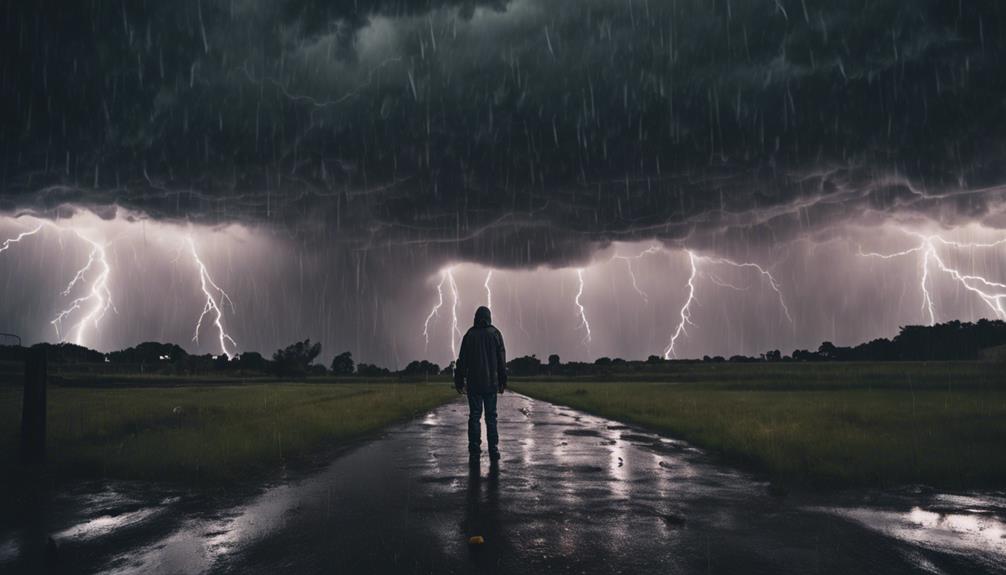Thunderstorms bring risks like strong winds, lightning strikes, tornadoes, hail, and flash floods. Understanding these dangers is important for staying safe during severe weather. Safety measures include being alert to storm alerts, taking necessary precautions, and following the 30/30 Rule. Large hail can cause damage, and damaging winds may lead to fallen trees and power outages. Seek shelter and secure loose objects outdoors. By learning about thunderstorm hazards and safety tips, individuals can protect themselves and their property. Further information on preparing for thunderstorms is available in the research provided.
Key Takeaways
- Beware of lightning strikes, which can cause fires and fatalities.
- Prepare for severe consequences like hailstorms, tornadoes, and microbursts.
- Stay informed with storm alerts, watches, and warnings for safety.
- Take cover during damaging winds to prevent injuries and property damage.
- Understand the 30/30 Rule: seek shelter if lightning is seen within 30 seconds of hearing thunder.
Thunderstorm Risks and Characteristics
What’re the primary risks and characteristics associated with thunderstorms?
Thunderstorms are known for their potential to bring strong winds, lightning, tornadoes, hail, and flash floods. Approximately 10% of thunderstorms are classified as severe, capable of producing straight-line winds exceeding 58 mph, large hail, and flash flooding.
Lightning strikes during thunderstorms pose a significant risk of fires and fatalities. These powerful natural phenomena can lead to unpredictable severe consequences, including hailstorms, tornadoes, and microbursts.
Understanding these risks and characteristics is vital for individuals to stay informed and prepared when facing the dangers of thunderstorms.
Safety Measures and Preparedness

Understanding storm alerts like watches and warnings is essential for one’s safety during thunderstorms. Being aware of weather conditions can help individuals take necessary precautions.
The 30/30 Rule, which suggests seeking shelter if thunder is heard within 30 seconds of seeing lightning and waiting 30 minutes after the storm passes before resuming outdoor activities, is a simple yet effective safety tip.
Reviewing past storm events can offer valuable insights for preparedness, enabling people to anticipate potential risks. Postponing outdoor activities during thunderstorms is a proactive measure to avoid exposure to lightning and other dangers.
Recognizing the signs of approaching thunderstorms and knowing how to prepare can significantly contribute to ensuring personal safety during severe weather events.
Thunderstorm Hazards and Safety Tips

How can individuals identify and mitigate thunderstorm hazards effectively for their safety? Severe thunderstorms present various risks, including large hail, damaging winds, and dangerous lightning. Being aware of these hazards is essential for taking appropriate safety measures. Here are some key safety tips:
| Thunderstorm Hazard | Potential Risks | Safety Measures |
|---|---|---|
| Large Hail | Property damage, vehicle dents, injuries | Park vehicles undercover, avoid exposure to the outdoors |
| Damaging Winds | Structural damage, fallen trees, power outages | Seek sturdy shelter, secure loose outdoor objects |
| Dangerous Lightning | Fires, fatalities, power surges | Stay indoors, unplug electronic devices |
Frequently Asked Questions
Can Thunderstorms Cause Disruptions in Communication Systems?
Thunderstorms can indeed disrupt communication systems, including power outages affecting cell towers and internet infrastructure. Lightning strikes can damage equipment, leading to service interruptions. It’s important to be aware of these risks.
How Do Thunderstorms Impact Wildlife and Ecosystems?
Thunderstorms impact wildlife and ecosystems through habitat destruction, flooding, and altered behavior patterns. They disturb ecosystems by causing disruptions in food chains and habitats. Understanding these impacts aids in conservation efforts and disaster preparedness.
Are There Specific Precautions for Pets During Thunderstorms?
During thunderstorms, pet owners should make sure their pets have a safe indoor space away from windows to reduce anxiety. Providing comforting items and staying calm helps pets feel secure. Avoiding outdoor walks until the storm passes is important.
Can Thunderstorms Affect Agricultural Crops and Farming Practices?
Thunderstorms, with their strong winds and hail, can ironically affect agricultural crops and farming practices. Farmers must monitor weather alerts, protect their crops, and adapt farming practices to mitigate the risks posed by thunderstorms.
What Are the Psychological Effects of Thunderstorms on Individuals?
Thunderstorms can induce fear, anxiety, and stress in individuals due to their unpredictable nature and potential hazards. Understanding these psychological effects is essential for promoting mental well-being during severe weather events.
Conclusion
To sum up, embracing the knowledge of thunderstorm dangers is key to staying safe. By understanding the risks and preparing accordingly, individuals can navigate these natural phenomena with caution and resilience.
Remember, knowledge is power in the face of nature’s unpredictability – arm yourself with information to weather the storm.









